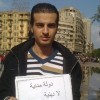This post is part of our special coverage Egypt Revolution 2011 [1].
The year 2011 is coming to an end, and with all the events took place in Egypt, it is important to list the most important or controversial blog posts of the year.
Maikel Nabil: “The Army and The People were never One Hand”
This blog post by Maikel Nabil Sanad [2] [ar] is important on many levels: Sanad was sentenced to jail for what wrote in that blog post, to be the first prisoner of conscience after the start of the Egyptian Revolution [3]. Also, the post came less than a month after Egyptian president Hosni Mubarak stepped down, when the moment the majority of Egyptians didn't criticize the military either out of fear or because they didn't see that they deserved any criticism.
What Sanad wrote in the post was challenging to the way many people used to see the military at the time. In the post, Sanad listed many examples of arrest and torture during and after the 18 days of the revolution that he saw as proof that the Army was never with the Egyptian revolution, and hence he was accused [4] of “insulting the military institution and publishing false news about it” and “disturbing the public security” – crimes for which he was sentenced to three years in prison [5], which were then reduced to two years.
Sanad continues a hunger strike, which he started almost 130 days ago, against his sentence. Add to all this, the fact that his arrest is not getting enough support on the street and in the media [6], because of his controversial opinions in his blog posts. However, it was this blog post that opened the door for breaking the taboo of criticising the military [7], and since then it became normal to see blogs criticizing and attacking it [8] [ar].
Mohamed Abo El-Ghait: “The Poor Come First Son of B*tches”
When I asked people on Twitter which blog posts they saw as the most important in 2011, this blog post [9] [ar] was the second one to get recommendations after Maikel Nabil's post. It was written in June, a few months after the constitution amendments referendum [10]. At the time, there was a huge debate on whether to have the parliamentary elections first and then let the parliament write the country's post-revolution constitution, or have a committee to write the constitution then have the parliamentary and presidential elections later on. The debate was huge, and reached its peak during the referendum.
Mohammed Abo El-Ghait wrote the post as he saw that the majority of those who participated in the revolution didn't care about such an “elitist” debate as their goal then was related to improving their living standards. In the post, he also did two important things, he first sort of coined that expression, which Alaa Abdel-Fattah used later on in another important blog post called “The Dream Comes First” [11] [ar], as well as many others who played on this expression in their discussions. The second thing he did, is that he challenged that mindset that the Egyptian revolution was a peaceful revolution powered by the middle and upper class.
He started his post with photos of poor people, or what Egyptian call “Sarsageyya,” making fun of them because the way they dress, the background and the visual effects they have in those photos, then he shocked the readers by telling them that those photos are for martyrs who died during the revolution even though the media insists on showing the photos of the middle-class martyrs only.
Alyaa El-Mahdy: “Nude Art”
We can have a similar debate to that that took place among the board of the Society of Independent Artists regarding Marcel Duchamp's urinal [13] whether what Alyaa El_Mahdy published in her blog post [12] [ar] was art or not. However, this post with the nude photographs of herself and some others is possibly one of the most visited blog posts in Egypt during this year. She has had more than 5 million visitors to her blog to date, and you can safely assume that almost all of those visits are to that specific post.
Alyaa has been featured and interviewed later on by many national and international newspapers, and Ahmed Abd El-Fatah also tweeted [14] [ar] that the feature about her in Al-Masry Al-Youm English (one of the leading English-language newspapers in Egypt) got the highest number of visits in the newspaper's history. Her decision to publish nude photos of herself also ignited a heated debate online [15] as well as offline. Personally, I know people who never read a blog post in their lives, yet have visited Alyaa's blog.
More Blog Posts
Three days before the beginning of the Egyptian revolution on January 25, and few days after the Tunisian one, Zeinobia wrote a list of lessons she believes we should learn from the Tunisian revolution [16]. One day after Mubarak stepped down, and while people were celebrating their victory and leaving Tahrir Square back to their homes, Hossam El-Hamalawy wrote a post warning that the revolution is far from over [17]. He also defended the workers’ right to strike, which he believes is an integral part the revolution just like demonstrations in the squares.
During the sit-in in Tahrir in July, Sandmonkey wrote a post entitled, “Tahrir: an Exercise in Nation Building [18]“, in it he said that away from the political value of the sit-in as a sort of pressure to achieve the revolution's demands, those taking part in the protest were having a fascinating social experiment as “Tahrir was very quickly becoming a miniature-size Egypt, with all of its problems, but without a centralized government. And the parallels are uncanny”. He went on comparing the parallels, and ended his post saying:
basically if you are interested in figuring out what the problems facing our society and the best way to solve them, Tahrir is where you should be heading to right now.
Sandmonkey's post reminds me of that post of Obliviology, where she to some extent also described Tahrir Square [19] but during the 18 days of the revolution this time. And finally, another interesting post is that of Karim Shafei [20] [ar] – which was featured by Ayesha Saldanha here [21] – where he described Cairo (the capital of Egypt) and in ironic way, compares it to mini-independent-states and not just a single city.
This post is part of our special coverage Egypt Revolution 2011 [1].


